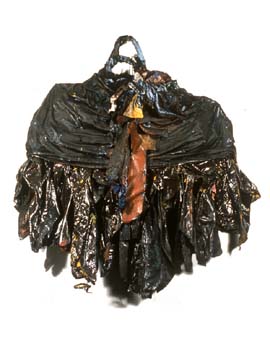Contemporary fiber artists have a lot of baggage to handle. They have so much baggage in fact that they had to knit a bigger bag to fit everything in. Fiber artists are rarely seen as the cool art kids who sit in the back of the bus and write “SLAYER” on the seat. Instead they are painted as the queer crafty kids who sit in front the bus, are friends with the driver, make friendship bracelets, and knit scarves. I’m sure performance or new media artists could argue for a similar unpopular position on the bus but their baggage would look less homespun.
Many contemporary fiber artists have made their fair share of friendship bracelets and knitted a few misshapen scarves but contemporary fiber practices are becoming more complex and draw from a history of labor, queer identity, craft, and feminism. This history includes rebel artists like Harmony Hammond, whose work is now considered important but in its time was too domestic for art critics and too gay for some feminists. In an article for the Journal of Modern Craft, Julia Bryan-Wilson points to some of Harmony Hammond’s conflicts with early feminist artist groups. She was an outsider among outsiders. Her work never shied away from crew-cut levels of lesbianism and was often viewed by some as threat to the goals of the Woman-made art movement of the early 70’s.

Josh Faught “Triage,” 2009. Hemp, nail polish, spray paint, indigo, logwood, toilet paper, greeting cards, pins, books, plaster, yarn, hand made wooden sign, denim, and gloves. Courtesy Lisa Cooley Fine Art
Some of Hammond’s work from that period used found textiles, rug braiding techniques, and acrylic paint to create often suggestive or blatantly queer objects. In her art, the domestic and low implications of fiber-based work created a space between painting and sculpture. The space she helped forge has grown and is now being utilized by contemporary fiber artists. This includes artists like Josh Faught, who approaches the impediments of feminism, hobby craft, and queer history with a sense of reverence and anxiety. In his piece Triage, Faught layers found objects like gay pride buttons and self-help books with hand woven and dyed textiles. His work reflects the present struggle for both fiber artists and queer people to assimilate yet maintain outsider status.

Josh Faught, “Triage (detail),” 2009. Hemp, nail polish, spray paint, indigo, logwood, toilet paper, greeting cards, pins, books, plaster, yarn, hand made wooden sign, denim, and gloves. Courtesy Lisa Cooley Fine Art
In an email conversation, I asked Josh about the place of queerness in contemporary craft. He wrote, “Recently, I’ve heard discussions that suggest that the site of queerness in fact, no longer resides in the body. But instead, it exists immaterially or spiritually, like a specter that has the ability to haunt culture.”

Josh Faught, "How to Beat the High Cost of Living (detail)," 2009. Hand woven cotton, nail polish, toilet paper, silk flowers, indigo, sequins, and ink. Courtesy Lisa Cooley Fine Art
In the context of craft, Faught’s post-body/post-queer work relieves itself from the questions of identity politics. His work instead turns to material as a way to manifest desire. Although trained as a textile designer and weaver, his craft leans towards what he calls the “inexpert hands.” By covering virtuosly-constructed textile structures with the detritus of a nervous life, he opens up a conversation between high and low craft. The expressiveness of his work requires both “inexpert” and expert hands to exist. With this gesture, his work allows the little boy who knits on the bus to own his seat as an outsider and turn it into something much stranger, something much cooler.
Josh Faught’s work will be included in the upcoming exhibition, The Craft, curated by Melissa Brown at the Lehman College Gallery in Bronx, NY. Harmony Hammond’s work can be viewed in many major collections, including the Art Institute of Chicago, Walker Arts Center, the Metropolitan Museum of Art, and the Brooklyn Museum of Art.




